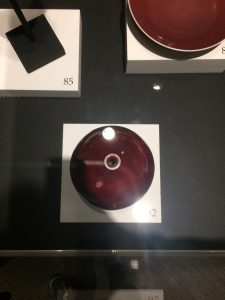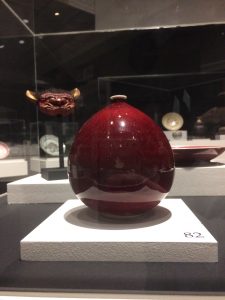In the Colors of Asia exhibit within the Ackland Art Museum, there lies a red vase created by Canadian artist Thomas Bezanson. The vase, titled so, is a porcelain piece with a red “sang de boeuf” glaze, which the French translation of “lang yao hong,” the Chinese method of glazing. It is named so for the oxblood color of the glaze, caused by a minute amount of copper place within the glaze.
The vase is almost perfectly spherical, tapering to an extremely small opening at the top. The neck is short, almost to the point where it might not even be considered a neck. The glaze has a glossy finish and coats the object uniformly, with the color being brighter near the top of the vase and fading to a dark red near the bottom. After visiting the UNC Art Lab and seeing a demonstration of the throwing wheel, I believe that the vase was created on a throwing wheel, considering the almost perfect spherical shape and the symmetry of the object, as an object that size could only be built up on a throwing wheel, which can hold a lot of weight, rather than being freely formed. Having attempted to form a pot by just freely forming clay, I believe that it would be nearly impossible to achieve the smooth, even finish as well as the symmetry of the vase that the artist managed to achieve.
Having also used the throwing wheel, I imagine one of the largest challenges must have been centering the vase on the pot and continuously breaking down and building up the vase in order to be able to build such a wide base, as well as being able to hollow the vase out and yet still manage to smoothly transition into a small opening. I believe glazing the vase was yet another challenge the artist faced, as the rim of the opening, which has a lip that protrudes outwards, remains unglazed. Likewise, the glaze is not a uniform color on the entirety of the vase, which may or may not have been the artist’s intention.
Though the nameplate next to the vase indicates that the vase is made of porcelain, it could be determined that the material used to craft the object is such due to the fact that is is extremely smooth as well as thin, especially where the opening of the vase is, as the opening is extremely small, thin, and pointed, especially in comparison to the rather large and bulbous object. This indicates that the opening was created with very precise actions, or else was created with tools that have the precision to create detailing that fine. The interesting thing about the fact that the vase is both made of porcelain and is red is that historically, in the west, porcelain has been kept white to maintain the “pure” image of the highly coveted material. Even in China, before the westernization of porcelain, porcelain has been glazed to remain white for the most part, or else blue and white glaze derived from a cobalt oxide derivative.
Because the artist is Canadian, I am curious about whether or not the vase is a modern twist on objects made of porcelain historically, in that the vase is first an unconventional color (within the context of the history of porcelain as a material), and the fact that the shape is both unconventional and not very ergonomic, given the bulbous shape of the vase as well as the small opening. The high value of porcelain and the rich color of the vase makes it possible that the vase was designed for decorative purposes. Compared to other modern artwork using porcelain, such as Aaron Wilcox’s “Nugget,” which seem to take the material of porcelain out of their historical contexts, in the sense that the artist coupled them with “cheap” materials, like zip ties, while Bezanson alters the convention slightly by simply altering the shape and color of the vase while maintaining the identifiability of the vase itself.


